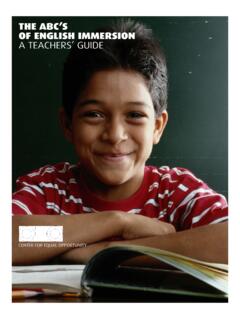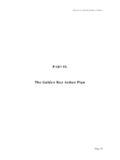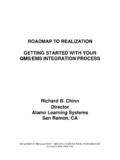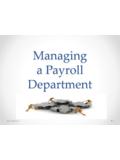Transcription of Too Many Asian Americans Affirmative …
1 Too Many Asian Americans : Affirmative Discrimination in Elite College Admissions Althea Nagai, Research Fellow Center for Equal Opportunity Linda Chavez, Chairman Roger Clegg, President & General Counsel 7700 Leesburg Pike, Suite 231 Falls Church, VA 22043 Phone 703-442-0066 Fax 703-442-0449 EMBARGOED UNTIL MAY 22, 2018 i Table of Contents Executive Summary .. 1 Acknowledgments .. 3 Introduction .. 4 The Asian American Population Explosion .. 6 Asian American Enrollment .. 7 Caltech and MIT .. 9 Racial/Ethnic Composition, Fall 2016 .. 9 Trends in Enrollment .. 10 And Then There s Harvard.
2 13 Comparing Racial & Ethnic Groups: Espenshade & Radford s Findings .. 15 Applicants with High SAT Scores by Race and Ethnicity .. 16 The Role of Extracurricular Activities .. 18 The Softer Factors .. 19 The Consequences of Holistic Admission .. 19 Appendix A. Categories of Race and Ethnicity .. 21 Appendix B. Public Universities .. 21 List of Figures Figure 1. Asian American Population (in Thousands) .. 6 Figure 2. Asian American Undergraduate Enrollment Over Time .. 7 Figure 3. Asian Americans Steep & Steady Rise at Caltech .. 11 Figure 4. A Ceiling on Asian Americans at MIT.
3 12 Figure 5. The Sharp Rise of and the Ceiling on Asian Americans at Harvard .. 13 Figure 6. Admission Rate by Race at Private Elite Universities for Those with SATs from 1400 to 1600 .. 17 List of Tables Table 1. Racial-Ethnic Composition of Undergraduates, Caltech & MIT, Fall 2016 .. 10 Table 2. Admission Rates by Race at Elite Private Institutions, Fall 1997 .. 15 Table 3. Undergraduate Admission Rate by SAT, at Elite Schools .. 16 1 Executive Summary Asian Americans are overrepresented in certain elite schools relative to their numbers in the population. In pursuit of racial and ethnic diversity, these schools will admit some Asian American applicants but not as many as their academic qualifications would justify.
4 As a case study, I examine three private universities and Asian American enrollment in those universities over time. No Ceiling on Asian Americans at Caltech But One at MIT and Harvard Caltech has no Affirmative action. The number of Asian American undergraduates hasincreased, quite steeply since 2000. They make up more than 40% of Caltech studentstoday. MIT uses race as a factor in admissions, but not legacy connections. The rise innumber of Asian Americans at MIT is halted in the 1990s. Peaking at 29%, thepercentage of Asian Americans at MIT has stalled at around 26%.
5 At Harvard, Asian Americans as a percentage of all undergraduates sharply increasedto 21%, then significantly dropped and has stayed at roughly 17%. Harvard uses raceas a factor in admissions, along with legacy connections. 2 Even when statistically controlling for other variables including social class, gender, extracurricular activities, test scores and grades, AP classes, and athletics, Asian American applicants were less likely to be admitted to America s elite colleges and universities compared to whites, African Americans , and Hispanics, according to scholars Thomas J.
6 Espenshade and Alexandria Walton Radford of Princeton University. So-called holistic admissions and diversity goals enable discrimination against Asian American applicants, much as the Harvard plan of the 1920s, also using holistic admissions, did against Jewish applicants. 3 Acknowledgments I would like to thank Linda Chavez and the staff at the Center for Equal Opportunity for giving me the chance to work on this essay on Asian Americans and elite university and college admissions. I especially want to thank Terry Eastland, for his close reading and numerous comments.
7 I also want to thank Rudy Gersten and Roger Clegg for suggestions and critique of the manuscripts. 4 Introduction Americans have long recognized that elite universities and colleges play a critical role in making it to the top of American society. A big name college degree, say from Harvard or Princeton, signals that one has been approved to enter the American elite. Such degree signaling does not guarantee entry, but it is definitely a big help. Yet because most elite schools use race and ethnicity as a factor in deciding whom to admit, their admissions procedures are often hotly debated.
8 In this context, many Asian Americans1 believe there is an admissions ceiling at some of our most competitive universities. This ceiling, in their view, limits the number of seats for which Asian American applicants may compete, and thus denies entry to Asian Americans who otherwise would be admitted, but for the fact they are of the wrong race. This belief is so prevalent among young, ambitious Asian Americans that many try to hide their identity when applying. Aaron Mak, a Chinese American student at Yale, admitted, [T]hat effort .. involved erasing it in order to appear white, or at least less Asian .
9 2 Mak wrote two personal essays, one on living with his immigrant Chinese grandfather for the University of California schools, where race is not a factor in admissions. The other essay for Yale made no mention of his ethnic roots. For Yale, he declined to check the race/ethnicity box, he picked a major that ran counter to stereotype, and he stayed away from activities associated with Asian Americans , spending time on other matters. I quit piano, viewing the instrument as a totem of my race s overeager striving in America. I opted to spend much of my time writing plays and film reviews pursuits I genuinely did find rewarding but which I also chose so I wouldn t be pigeonholed.
10 3 Concern about discrimination in admissions against Asian Americans goes beyond the ethnic community. The 2006 National Association for College Admission Counseling annual meeting held a session titled, Too Asian ? Panelists noted that teachers, counselors, and admissions officers tended to see Asian Americans as a group rather than as individuals,4 and that admissions consultants advised Asian American clients to choose extracurricular activities and prospective majors that worked against 1 Asian Americans refer to persons with ancestry from East Asia, Southeast Asia, and the Indian subcontinent.







